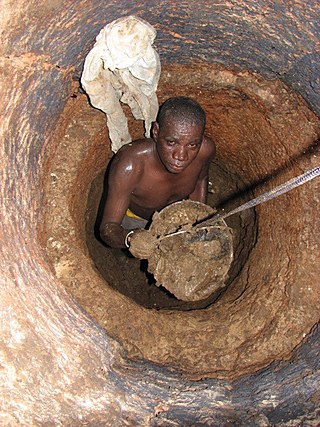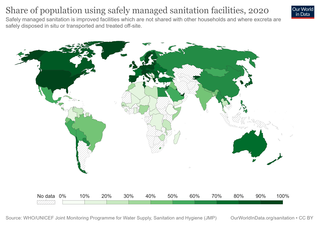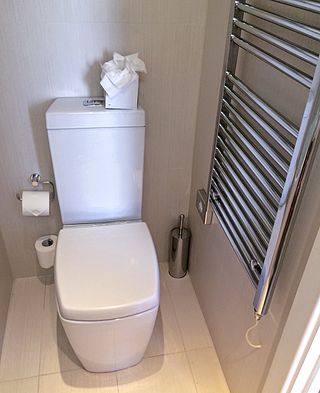
Sanitation refers to public health conditions related to clean drinking water and treatment and disposal of human excreta and sewage. Preventing human contact with feces is part of sanitation, as is hand washing with soap. Sanitation systems aim to protect human health by providing a clean environment that will stop the transmission of disease, especially through the fecal–oral route. For example, diarrhea, a main cause of malnutrition and stunted growth in children, can be reduced through adequate sanitation. There are many other diseases which are easily transmitted in communities that have low levels of sanitation, such as ascariasis, cholera, hepatitis, polio, schistosomiasis, and trachoma, to name just a few.

An outhouse is a small structure, separate from a main building, which covers a toilet. This is typically either a pit latrine or a bucket toilet, but other forms of dry (non-flushing) toilets may be encountered. The term may also be used to denote the toilet itself, not just the structure.

A sty or pigsty is a small-scale outdoor enclosure for raising domestic pigs as livestock. It is sometimes referred to as a hog pen, hog parlor, pigpen, pig parlor, or pig-cote, although pig pen may refer to pens confining pigs that are kept as pets as well. Pigsties are generally fenced areas of bare dirt and/or mud. "Sty" and "pigsty" are used as derogatory descriptions of dirty, messy areas, the word sty deriving from the Proto-Germanic *stiją meaning filthy hovel. There are three contributing reasons that pigs, generally clean animals, create such a living environment:

Night soil is a historically used euphemism for human excreta collected from cesspools, privies, pail closets, pit latrines, privy middens, septic tanks, etc. This material was removed from the immediate area, usually at night, by workers employed in this trade. Sometimes it could be transported out of towns and sold on as a fertilizer.
Human waste refers to the waste products of the human digestive system, menses, and human metabolism including urine and feces. As part of a sanitation system that is in place, human waste is collected, transported, treated and disposed of or reused by one method or another, depending on the type of toilet being used, ability by the users to pay for services and other factors. Fecal sludge management is used to deal with fecal matter collected in on-site sanitation systems such as pit latrines and septic tanks.

A pit latrine, also known as pit toilet, is a type of toilet that collects human waste in a hole in the ground. Urine and feces enter the pit through a drop hole in the floor, which might be connected to a toilet seat or squatting pan for user comfort. Pit latrines can be built to function without water or they can have a water seal. When properly built and maintained, pit latrines can decrease the spread of disease by reducing the amount of human feces in the environment from open defecation. This decreases the transfer of pathogens between feces and food by flies. These pathogens are major causes of infectious diarrhea and intestinal worm infections. Infectious diarrhea resulted in about 700,000 deaths in children under five years old in 2011 and 250 million lost school days. Pit latrines are a low-cost method of separating feces from people.

A bucket toilet is a basic form of a dry toilet whereby a bucket (pail) is used to collect excreta. Usually, feces and urine are collected together in the same bucket, leading to odor issues. The bucket may be situated inside a dwelling, or in a nearby small structure.

Ecological sanitation, commonly abbreviated as ecosan, is an approach to sanitation provision which aims to safely reuse excreta in agriculture. It is an approach, rather than a technology or a device which is characterized by a desire to "close the loop", mainly for the nutrients and organic matter between sanitation and agriculture in a safe manner. One of the aims is to minimise the use of non-renewable resources. When properly designed and operated, ecosan systems provide a hygienically safe system to convert human excreta into nutrients to be returned to the soil, and water to be returned to the land. Ecosan is also called resource-oriented sanitation.

Community-led total sanitation (CLTS) is an approach used mainly in developing countries to improve sanitation and hygiene practices in a community. The approach tries to achieve behavior change in mainly rural people by a process of "triggering", leading to spontaneous and long-term abandonment of open defecation practices. It focuses on spontaneous and long-lasting behavior change of an entire community. The term "triggering" is central to the CLTS process: it refers to ways of igniting community interest in ending open defecation, usually by building simple toilets, such as pit latrines. CLTS involves actions leading to increased self-respect and pride in one's community. It also involves shame and disgust about one's own open defecation behaviors. CLTS takes an approach to rural sanitation that works without hardware subsidies and that facilitates communities to recognize the problem of open defecation and take collective action to clean up and become "open defecation free".

Manual scavenging is a term used mainly in India for "manually cleaning, carrying, disposing of, or otherwise handling, human excreta in an insanitary latrine or in an open drain or sewer or in a septic tank or a pit". Manual scavengers usually use hand tools such as buckets, brooms and shovels. The workers have to move the excreta, using brooms and tin plates, into baskets, which they carry to disposal locations sometimes several kilometers away. The practice of employing human labour for cleaning of sewers and septic tanks is also prevalent in Bangladesh and Pakistan. These sanitation workers, called "manual scavengers", rarely have any personal protective equipment. The work is regarded as a dehumanizing practice.

Sustainable sanitation is a sanitation system designed to meet certain criteria and to work well over the long-term. Sustainable sanitation systems consider the entire "sanitation value chain", from the experience of the user, excreta and wastewater collection methods, transportation or conveyance of waste, treatment, and reuse or disposal. The Sustainable Sanitation Alliance (SuSanA) includes five features in its definition of "sustainable sanitation": Systems need to be economically and socially acceptable, technically and institutionally appropriate and protect the environment and natural resources.

Improved sanitation is a term used to categorize types of sanitation for monitoring purposes. It refers to the management of human feces at the household level. The term was coined by the Joint Monitoring Program (JMP) for Water Supply and Sanitation of UNICEF and WHO in 2002 to help monitor the progress towards Goal Number 7 of the Millennium Development Goals (MDGs). The opposite of "improved sanitation" has been termed "unimproved sanitation" in the JMP definitions. The same terms are used to monitor progress towards Sustainable Development Goal 6 from 2015 onwards. Here, they are a component of the definition for "safely managed sanitation service".

A toilet is a piece of sanitary hardware that collects human urine and feces, and sometimes toilet paper, usually for disposal. Flush toilets use water, while dry or non-flush toilets do not. They can be designed for a sitting position popular in Europe and North America with a toilet seat, with additional considerations for those with disabilities, or for a squatting posture more popular in Asia, known as a squat toilet. In urban areas, flush toilets are usually connected to a sewer system; in isolated areas, to a septic tank. The waste is known as blackwater and the combined effluent, including other sources, is sewage. Dry toilets are connected to a pit, removable container, composting chamber, or other storage and treatment device, including urine diversion with a urine-diverting toilet.

A sanitation worker is a person responsible for cleaning, maintaining, operating, or emptying the equipment or technology at any step of the sanitation chain. This is the definition used in the narrower sense within the WASH sector. More broadly speaking, sanitation workers may also be involved in cleaning streets, parks, public spaces, sewers, storm
A toilet god is a deity associated with latrines and toilets. Belief in toilet gods – a type of household deity – has been known from both modern and ancient cultures, ranging from Japan to ancient Rome. Such deities have been associated with health, well-being and fertility and have been propitiated in a wide variety of ways, including making offerings, invoking and appeasing them through prayers, meditating and carrying out ritual actions such as clearing one's throat before entering or even biting the latrine to transfer spiritual forces back to the god.

The harvesting and consuming of seafoods are ancient practices that may date back to at least the Upper Paleolithic period which dates to between 50,000 and 10,000 years ago. Isotopic analysis of the skeletal remains of Tianyuan man, a 40,000-year-old modern human from eastern Asia, has shown that he regularly consumed freshwater fish. Archaeology features such as shell middens, discarded fish bones and cave paintings show that sea foods were important for survival and consumed in significant quantities. During this period, most people lived a hunter-gatherer lifestyle and were, of necessity, constantly on the move. However, where there are early examples of permanent settlements such as those at Lepenski Vir, they are almost always associated with fishing as a major source of food.

Reuse of human excreta is the safe, beneficial use of treated human excreta after applying suitable treatment steps and risk management approaches that are customized for the intended reuse application. Beneficial uses of the treated excreta may focus on using the plant-available nutrients that are contained in the treated excreta. They may also make use of the organic matter and energy contained in the excreta. To a lesser extent, reuse of the excreta's water content might also take place, although this is better known as water reclamation from municipal wastewater. The intended reuse applications for the nutrient content may include: soil conditioner or fertilizer in agriculture or horticultural activities. Other reuse applications, which focus more on the organic matter content of the excreta, include use as a fuel source or as an energy source in the form of biogas.

Container-based sanitation refers to a sanitation system where toilets collect human excreta in sealable, removable containers that are transported to treatment facilities. This type of sanitation involves a commercial service which provides certain types of portable toilets, and delivers empty containers when picking up full ones. The service transports and safely disposes of or reuses collected excreta. The cost of collection of excreta is usually borne by the users. With suitable development, support and functioning partnerships, CBS can be used to provide low-income urban populations with safe collection, transport and treatment of excrement at a lower cost than installing and maintaining sewers. In most cases, CBS is based on the use of urine-diverting dry toilets.

Emergency sanitation is the management and technical processes required to provide sanitation in emergency situations. Emergency sanitation is required during humanitarian relief operations for refugees, people affected by natural disasters and internally displaced persons. There are three phases of emergency response: Immediate, short term and long term. In the immediate phase, the focus is on managing open defecation, and toilet technologies might include very basic latrines, pit latrines, bucket toilets, container-based toilets, chemical toilets. The short term phase might also involve technologies such as urine-diverting dry toilets, septic tanks, decentralized wastewater systems. Providing handwashing facilities and management of fecal sludge are also part of emergency sanitation.





















